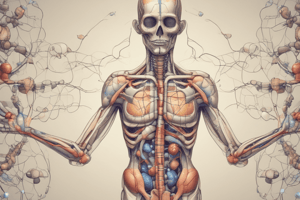Podcast
Questions and Answers
Which opioid receptor is primarily responsible for analgesia, euphoria, and respiratory depression?
Which opioid receptor is primarily responsible for analgesia, euphoria, and respiratory depression?
- Delta (δ) receptors
- Kappa (κ) receptors
- Mu (μ) receptors (correct)
- Sigma (σ) receptors
Which brain region is primarily involved in the modulation of pain?
Which brain region is primarily involved in the modulation of pain?
- Ventral tegmental area (VTA)
- Locus coeruleus
- Somatosensory cortex
- Periaqueductal gray (PAG) (correct)
What is a common side effect associated with all opioids?
What is a common side effect associated with all opioids?
- Constipation (correct)
- Insomnia
- Increased appetite
- Diarrhea
Which opioid is often used for managing breakthrough pain?
Which opioid is often used for managing breakthrough pain?
What effect do opioids have on neurotransmitter release?
What effect do opioids have on neurotransmitter release?
Which opioid is a partial agonist with a ceiling effect, making it safer in overdose?
Which opioid is a partial agonist with a ceiling effect, making it safer in overdose?
Which opioid is associated with a risk of QT prolongation?
Which opioid is associated with a risk of QT prolongation?
What condition is a contraindication or requires cautious use of opioids?
What condition is a contraindication or requires cautious use of opioids?
Which mnemonic helps remember common opioids?
Which mnemonic helps remember common opioids?
What effect do opioids have on cAMP levels in neurons?
What effect do opioids have on cAMP levels in neurons?
Which of the following is a common symptom of opioid withdrawal?
Which of the following is a common symptom of opioid withdrawal?
Which opioid is a full agonist with a long half-life, used to prevent opioid withdrawal symptoms?
Which opioid is a full agonist with a long half-life, used to prevent opioid withdrawal symptoms?
What is the primary effect of opioids on potassium channels in neurons?
What is the primary effect of opioids on potassium channels in neurons?
Which brain area is primarily associated with reward and dopamine release related to opioid use?
Which brain area is primarily associated with reward and dopamine release related to opioid use?
What is miosis, a common side effect of opioid use?
What is miosis, a common side effect of opioid use?
What is a significant risk associated with fentanyl due to its high potency?
What is a significant risk associated with fentanyl due to its high potency?
Which medication is an opioid antagonist used for relapse prevention in opioid use disorder?
Which medication is an opioid antagonist used for relapse prevention in opioid use disorder?
What is a potential effect of chronic opioid use regarding pain sensitivity?
What is a potential effect of chronic opioid use regarding pain sensitivity?
Which of the following is an off-label medication sometimes used for opioid withdrawal symptoms?
Which of the following is an off-label medication sometimes used for opioid withdrawal symptoms?
What is the effect of opioids on calcium channels in neurons?
What is the effect of opioids on calcium channels in neurons?
Flashcards
Mu-opioid receptors (μ)
Mu-opioid receptors (μ)
Analgesia, euphoria, respiratory depression, dependence; Located in PAG, thalamus, brainstem, spinal cord.
Delta (δ) receptors
Delta (δ) receptors
Modulate analgesia and mood regulation; Found in limbic system, cortex, and spinal cord.
Kappa (κ) receptors
Kappa (κ) receptors
Contribute to analgesia, dysphoria, and sedation; Located in spinal cord and hypothalamus.
Opioid Neurotransmitter Effects
Opioid Neurotransmitter Effects
Signup and view all the flashcards
Opioid Indications
Opioid Indications
Signup and view all the flashcards
Methadone
Methadone
Signup and view all the flashcards
Buprenorphine
Buprenorphine
Signup and view all the flashcards
Naltrexone
Naltrexone
Signup and view all the flashcards
Common Opioid Side Effects
Common Opioid Side Effects
Signup and view all the flashcards
Severe Opioid Side Effects
Severe Opioid Side Effects
Signup and view all the flashcards
Fentanyl Risks
Fentanyl Risks
Signup and view all the flashcards
Methadone Risks
Methadone Risks
Signup and view all the flashcards
Tramadol Risks
Tramadol Risks
Signup and view all the flashcards
Buprenorphine Safety
Buprenorphine Safety
Signup and view all the flashcards
Opioid Contraindications
Opioid Contraindications
Signup and view all the flashcards
Hyperalgesia
Hyperalgesia
Signup and view all the flashcards
Opioids Mechanism on cAMP
Opioids Mechanism on cAMP
Signup and view all the flashcards
K⁺ and Ca²⁺ Channels
K⁺ and Ca²⁺ Channels
Signup and view all the flashcards
Periaqueductal gray (PAG)
Periaqueductal gray (PAG)
Signup and view all the flashcards
Locus Coeruleus
Locus Coeruleus
Signup and view all the flashcards
Study Notes
- Study notes on Opioids
Names of the Drugs & Mnemonics
- Common Opioids by potency/use mnemonic: "My Friend Has Some Craving But May Never Quit"
- The mnemonic represents: Morphine, Fentanyl, Hydromorphone, Sufentanil, Codeine, Buprenorphine, Methadone, Naloxone and Quit = withdrawal meds.
Mechanism of Action (Detailed)
- Primary Receptor Targets: Mu, Delta, and Kappa opioid receptors in the brain and spinal cord
- Mu-opioid receptors (μ) are the main site of analgesia, euphoria, respiratory depression, and dependence
- Located in the periaqueductal gray (PAG), thalamus, brainstem, and spinal cord dorsal horn
- Delta (δ) receptors modulate analgesia and mood regulation
- Found in the limbic system, cortex, and spinal cord
- Kappa (κ) receptors contribute to analgesia, dysphoria, and sedation
- Located in the spinal cord and hypothalamus
- Brain Regions Affected: Periaqueductal gray (PAG): Pain modulation, Thalamus & somatosensory cortex: Pain perception, Ventral tegmental area (VTA): Reward pathway (dopamine release), Locus coeruleus: Arousal, stress (inhibition = sedation), Brainstem (medulla): Respiratory center
- Neurotransmitter Effects: Inhibit release of excitatory neurotransmitters (e.g., glutamate, substance P), Activate Gi protein-coupled receptors → inhibit adenylyl cyclase → ↓ cAMP, Open K⁺ channels (hyperpolarization) and close Ca²⁺ channels → ↓ neurotransmitter release
Indications
- Severe acute pain (e.g., post-surgical, trauma) – Morphine, Hydromorphone, Fentanyl
- Chronic cancer pain – Oxycodone, Methadone
- Breakthrough pain – Fentanyl patches or lozenges
- Moderate pain – Codeine, Tramadol
- Opioid Withdrawal Management:
- Methadone: Full agonist, long half-life, prevents withdrawal symptoms
- Buprenorphine: Partial agonist; less risk of overdose, ceiling effect
- Naltrexone: Opioid antagonist; relapse prevention
- Clonidine (off-label): For withdrawal symptoms (not an opioid)
Side Effects
- Common to All Opioids: Respiratory depression, Sedation, Nausea, vomiting, Constipation (very common), Miosis (pinpoint pupils), Euphoria → Addiction risk, Tolerance & dependence
- Severe/High-Risk Side Effects: Respiratory arrest (esp. fentanyl, high-dose morphine), Severe hypotension (IV use), Overdose → coma, death, Hyperalgesia (increased pain sensitivity with chronic use)
- Drugs with Most Harmful Side Effects:
- Fentanyl: High potency = high overdose risk
- Methadone: Risk of QT prolongation, respiratory depression
- Heroin (illicit morphine derivative): High abuse/death rate
- Drugs with Least Harmful Side Effects:
- Tramadol: Less respiratory depression, but seizure risk
- Buprenorphine: Safer in overdose due to ceiling effect
- Codeine: Mild, but not suitable in CYP2D6 ultrarapid metabolizers (↑ morphine conversion)
Contraindications
- Avoid or use cautiously in:
- Respiratory disorders (COPD, sleep apnea)
- Concurrent CNS depressant use (benzos, alcohol)
- History of substance use disorder (unless used in MAT)
- Head injury (↑ intracranial pressure)
- Pregnancy (esp. early trimester or chronic use)
Studying That Suits You
Use AI to generate personalized quizzes and flashcards to suit your learning preferences.




